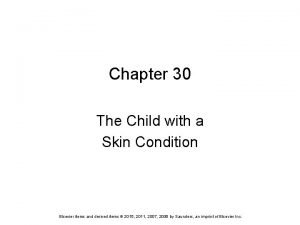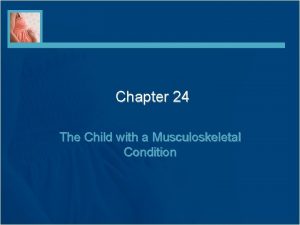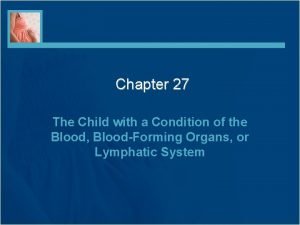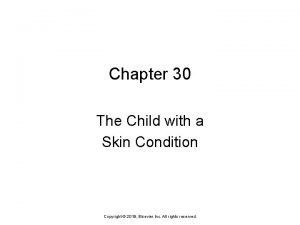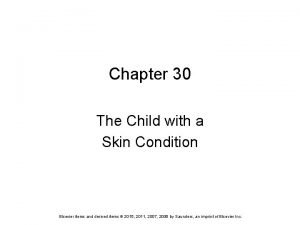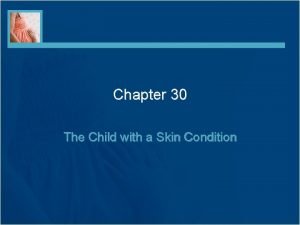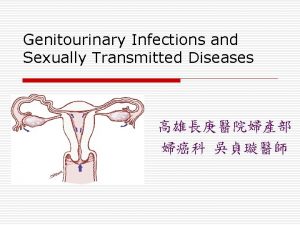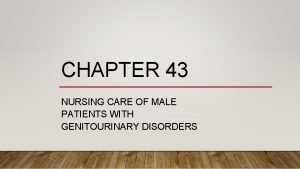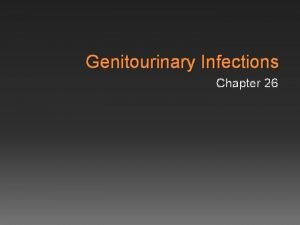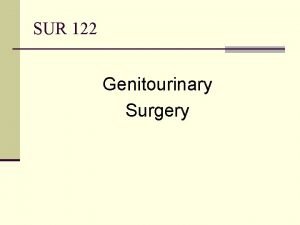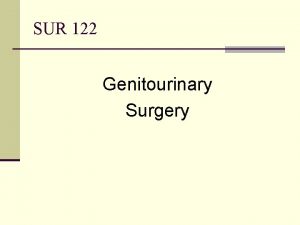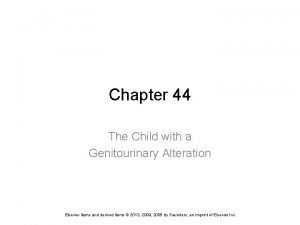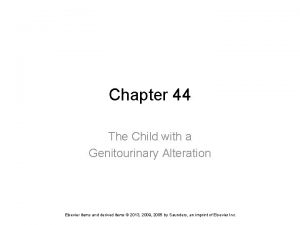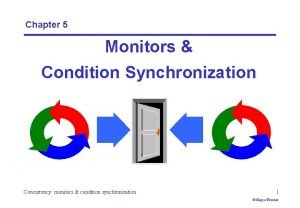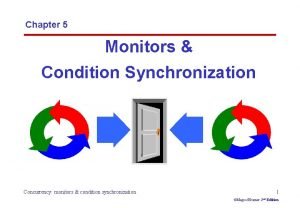Chapter 29 The Child with a Genitourinary Condition
















- Slides: 16

Chapter 29 The Child with a Genitourinary Condition

Urinary System • Consists of 2 kidneys, 2 ureters, the bladder, & urethra • Function is to rid body of waste & maintain body fluid homeostasis • Produce a substance (ESF) that stimulates RBC formation in bone marrow and renin, which regulates blood pressure • Kidneys produce substances that stimulate RBC production • The functional unit of the kidney is the nephron • The kidney & ear develops from the same tissue

Sexual Abuse in Children • May be manifested by behaviors, such as – – – – Urinary frequency Excessive masturbation Encopresis (fecal soiling beyond 4 years old) Severe nightmare Bedwetting Irritation or pain in genital area Decrease in physical or emotional development

Assessment of Urinary Function • Urological diagnostic procedures – – – – – UA Ultrasound IV pyelogram CT scan of kidneys Biopsy Uroflow Cystoscopy Voiding cystourethrography Cystometrogram Urethral pressure

Terms Commonly Used to Describe Urinary Dysfunction • • Dysuria Frequency Urgency Nocturia Enuresis Polyuria Oliguria

Phimosis • A narrowing of the • Forcible retraction of preputial opening of the tight foreskin is avoided foreskin • Foreskin cannot be – Prevents foreskin from returned to its normal being retracted over penis position – Normal in newborn, • Swelling and impaired disappears by age 3 circulation caused by – Corrected by circumcision constriction

Epispadias and Hypospadias • Epispadias • In mild cases surgery – Urinary meatus is on the is not indicated upper surface of the penis • Surgery is usually • Hypospadias performed before 18 – Congenital defect in which months of age the urinary meatus is located on the lower portion • Routine circumcision is avoided in these of the shaft children, because – May be accompanied by chordee, a downward foreskin may be curvature of the penis from useful in the repair a fibrous band of tissue

Acute Urinary Tract Infection (UTI) • More common in girls • Normal urine is acidic – Girls have a shorter – Alkaline urine favors urethra, location of urethra pathogens is near anus, wearing of • S & S older children – close-fitting nylon urgency, painful underwear, bubble baths, urination, bedwetting retention of urine, and vaginitis • S& S infants – fever, • Most caused by E. coli • Tx – antibiotics, fluids freq urination, foulsmelling urine, persistent diaper rash

Health Promotion • Interventions to prevent UTI – – – – Cleanse perineum with each diaper change Wipe perineum front to back Avoid bubble baths Have child urinate immediately after a bath Use white cotton underwear Use loose-fitting pants Offer adequate fluid intake

Nephrotic Syndrome (Nephrosis) • A number of different types of kidney conditions distinguished by the presence of marked amounts of protein in the urine, edema, and hypoalbuminemia – More common in boys – Seen more in children 2 to 7 years of age • S & S: Generalized edema, wt gain, pale, listless, poor appetite, normal BP, • Urine exam reveals massive albumin and a few RBCs

Nephrotic Syndrome (Nephrosis) (cont. ) • Treatment – Steroids to reduce proteinuria and edema • Steroids mask infection; therefore, it is important to monitor the child for signs of infection – Prevent medication toxicity – Diuretics have not been effective in reducing nephrotic edema – Avoid adding salt to foods whenever edema is present – Fluids generally are not restricted except when massive edema is present – Tx lasts long time

Nephrotic Syndrome (Nephrosis) (cont. ) • Nursing care – Supportive care to parents and child – Parent instructed to keep daily record of the child’s weight, urinary protein levels, and medications – No vaccinations or immunizations should be administered while the disease is active or during immunosuppressive therapy – Positioning – Strict monitoring of I&O – Daily weight and protection from infection

Acute Glomerulonephritis • Allergic reaction (antigen-antibody) to group A beta-hemolytic streptococcal infection • Mild cases generally recover within a couple of weeks • S&S: periorbital edema, urine is brown/bloody • High BUN, creatine, and sed rate • N. I. : rest with only quiet activities until hematuria subsides – Prevention of becoming overly tired, chilled, or exposed to infection

Wilms’ Tumor (Nephroblastoma) • One of the most common malignancies of early life, usually before age 3 • Few or no symptoms during the early stages of growth • Abdominal mass usually found by parent or during routine health checkup • Tx: surgery to remove kidney & tumor, radiation & chemo • N. I. : avoid unnecessary handling of the abdomen because can cause the tumor to be spread. NO ABDOMINAL PALPATION

Cryptorchidism • Testes fail to descend into the scrotum • Unilateral form is more common • Testes are warmer in abdomen, sperm cells begin to deteriorate • If both testes are involved, sterility can result • Often accompanied by inguinal hernia • Testes continue to secrete hormones directly into the bloodstream, so secondary sex characteristics are not affected • Tx: HCG or orchioplexy

Elsevier items and derived items © 2011, 2007, 2006 by Saunders, an imprint of Elsevier Inc. 16
 Chapter 29 the child with a genitourinary condition
Chapter 29 the child with a genitourinary condition Chapter 29 the child with a genitourinary condition
Chapter 29 the child with a genitourinary condition Chapter 30 the child with a skin condition
Chapter 30 the child with a skin condition Chapter 24 the child with a musculoskeletal condition
Chapter 24 the child with a musculoskeletal condition Chapter 27 the child with a condition of the blood
Chapter 27 the child with a condition of the blood Chapter 30 the child with a skin condition
Chapter 30 the child with a skin condition Chapter 30 the child with a skin condition
Chapter 30 the child with a skin condition Chapter 30 the child with a skin condition
Chapter 30 the child with a skin condition Genitourinary & stds
Genitourinary & stds Male genitourinary anatomy
Male genitourinary anatomy Nursing diagnosis for undescended testis
Nursing diagnosis for undescended testis Controlled radius
Controlled radius Left child right sibling tree
Left child right sibling tree Hình ảnh bộ gõ cơ thể búng tay
Hình ảnh bộ gõ cơ thể búng tay Bổ thể
Bổ thể Tỉ lệ cơ thể trẻ em
Tỉ lệ cơ thể trẻ em


